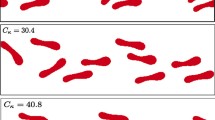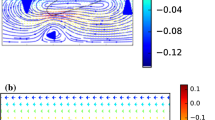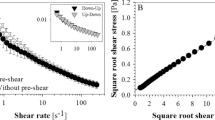Abstract
The structural organization of the dispersed phase of blood was studied by measuring the conductance (G) and the capacitance (C) of red blood cell (RBC) suspensions flowing in a vertical channel. Steady-state C and G signals exhibit erratic fluctuations around mean values; the root mean square of the fluctuating signals decreases rapidly as the average flow rate (<υ>) increases from 0.21 to ~4.17 mm/s and then less rapidly at higher velocities. The intensity of oscillations is substantially reduced for suspensions with weaker aggregating media. Analysis of the fluctuations performed in the framework of the equivalent electrical circuits for flowing blood gives rise to the following conclusions: (1) Instantaneous hematocrit (Hct) and velocity cross-stream profiles are non-smooth functions of radial position. (2) Oscillations of conductance at low flow conditions reflect irregular changes in the RBC network structure caused by fluctuations of aggregation-disaggregation equilibrium in the non-uniform shear field. (3) A transformation of the rheological behavior of RBC suspensions from shear-thinning to shear-thickening in a low flow regime amplifies fluctuations of aggregation–disaggregation equilibrium.







Similar content being viewed by others
Abbreviations
- C :
-
The capacitance
- G :
-
The conductance
- f :
-
The frequency of the electrical field
- Hct:
-
The volume fraction of erythrocytes termed hematocrit
- Hctf :
-
The feed Hct
- Hctcore and Hctc :
-
The core Hct and hematocrit at the centerline
- \( {\text{Hct}}_{\text{core}}^{\max } \) and \( {\text{Hct}}_{\text{c}}^{\max } \) :
-
The maximal possible Hct in the central flow region and at the centerline
- Hct(x, y):
-
The two-dimensional Hct distribution function
- L :
-
The length of the monitored blood flow
- l m :
-
The characteristic thickness of the cell-depleted marginal layer
- r :
-
The distance from the centerline of flow
- R l and R core :
-
The electrical resistances of the marginal layer and the Hct core
- w ch :
-
The width of the flow channel
- σ :
-
The conductivity
- σ(x, y):
-
The two-dimensional σ distribution function
- υ:
-
The flow rate
References
Beving, H., L. E. Eriksson, C. L. Davey, and D. B. Kell. Dielectric properties of human blood and erythrocytes at radio frequencies (0.2–10 MHz); dependence on cell volume fraction and medium composition. Eur. Biophys. J. 23:207–215, 1994.
Bishop, J. J., P. R. Nance, A. S. Popel, M. Intaglietta, and P. C. Johnson. Effect of erythrocyte aggregation on velocity profiles in venules. Am. J. Physiol. Heart Circ. Physiol. 280:H222–H236, 2001.
Bishop, J. J., A. S. Popel, M. Intaglietta, and P. C. Johnson. Effect of aggregation and shear rate on the dispersion of red blood cells flowing in venules. Am. J. Physiol. Heart Circ. Physiol. 283:H1985–H1996, 2002.
Cokelet, G. R. Viscometric, in vitro and in vivo blood viscosity relationships: how are they related? Biorheology 36:343–358, 1999.
Cokelet, G. R., and H. L. Goldsmith. Decreased hydrodynamic resistance in the two-phase flow of blood through small vertical tubes at low flow rates. Circ. Res. 68:1–17, 1991.
Fåhraeus, R. The suspension stability of blood. Physiol. Rev. 9:241–274, 1929.
Goldsmith, H. L. Poiseuille medial award lecture: from papermaking fibers to human blood cells. Biorheology 30:165–190, 1993.
Picart, C., J.-M. Piau, H. Galliard, and P. Carpentier. Blood low shear flow rheometry: influence of fibrinogen level and hematocrit on slip and migrational effects. Biorheology 35:335–353, 1998.
Prakash, B., and M. Singh. Optimum kinetic energy dissipation to maintain blood flow in glass capillaries: an analysis based on flow field determination by axial tomographic and image velocimetry techniques. J. Biomech. 28:649–659, 1995.
Pribush, A., H. J. Meiselman, D. Meyerstein, and N. Meyerstein. Dielectric approach to investigation of erythrocyte aggregation. I. Experimental basis of the method. Biorheology 36:411–423, 1999.
Pribush, A., H. J. Meiselman, D. Meyerstein, and N. Meyerstein. Dielectric approach to investigation of erythrocyte aggregation. II. Kinetics of erythrocyte aggregation-disaggregation in quiescent and flowing blood. Biorheology 37:429–441, 2000.
Pribush, A., D. Meyerstein, and N. Meyerstein. Conductometric study of shear-dependent processes in red cell suspensions. I. Effect of red blood cell aggregate morphology on blood conductance. Biorheology 41:13–28, 2004.
Pribush, A., H. J. Meiselman, D. Meyerstein, and N. Meyerstein. Conductometric study of shear-dependent processes in red cell suspensions. II. Transient cross-stream hematocrit distribution. Biorheology 41:29–44, 2004.
Reinke, W., P. C. Johnson, and P. Gaehtgens. Effect of shear rate variation on apparent viscosity of human blood in tubes of 29 to 94 microns diameter. Circ. Res. 59:124–132, 1986.
Verduin, H., B. J. de Gans, and J. K. G. Dhont. Shear induced structural changes in a gel-forming suspension studied by light scattering and rheology. Langmuir 12:2947–2955, 1996.
Acknowledgments
This study was supported by grants from the Israel Science Foundation (ISF) and from the United States-Israel Science Foundation (BSF).
Author information
Authors and Affiliations
Corresponding author
Rights and permissions
About this article
Cite this article
Pribush, A., Meiselman, H.J., Meyerstein, D. et al. Irregular Changes in the Structure of Flowing Blood at Low Flow Conditions. Ann Biomed Eng 37, 2488–2496 (2009). https://doi.org/10.1007/s10439-009-9800-4
Received:
Accepted:
Published:
Issue Date:
DOI: https://doi.org/10.1007/s10439-009-9800-4




